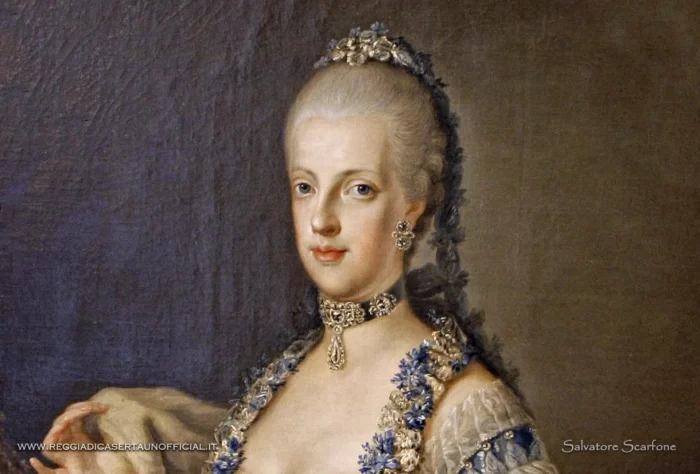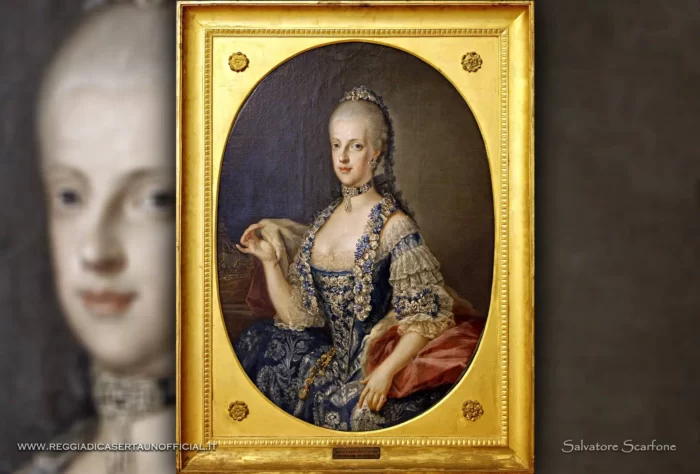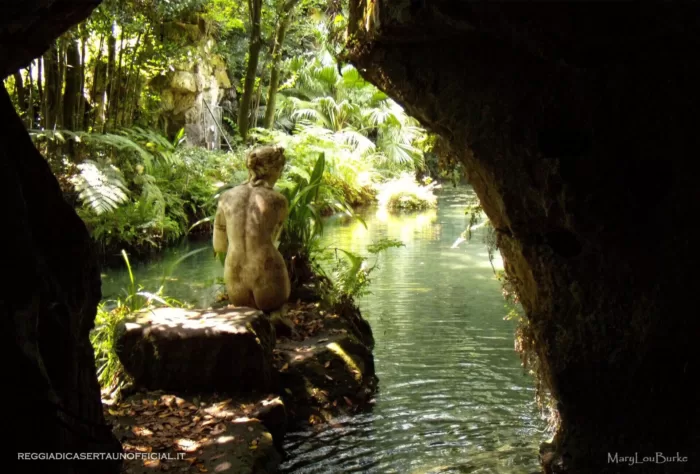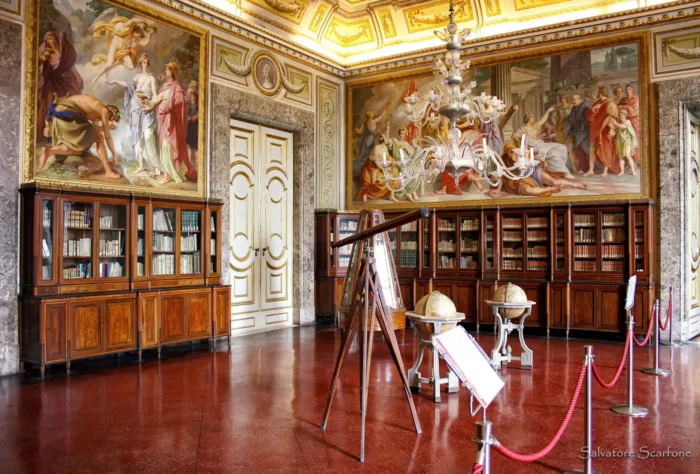Maria Carolina of Habsburg - Lorraine
Maria Carolina of Habsburg - Lorraine was a Queen with a strong personality, a Freemason, creator of the English Garden and, probably, the creator of socialism
The origins of Maria Carolina of Habsburg-Lorraine
Maria Carolina of Habsburg-Lorraine (Wien, 13 August 1752 – Wien, 8 September 1814)
In 1768, a new queen ascended the throne of Naples, the sixteen-year-old Maria Carolina of Habsburg. Intended for Ferdinand IV after the death of two sisters – Maria Giovanna and Maria Giuseppa – she was proposed by Maria Teresa to Charles III of Spain :
«Since I am certainly no less anxious to relate my family to that of the V.M. that you want to testify to me, I grant you with great pleasure one of the daughters that remain to me to make up for the loss of the one we regret. Now I have two who might be suitable: one is the Archduchess Amalia, considered beautiful and whose health seems to promise a large succession; the other is the archduchess Carlotta, who is also in very good health and about a year and seven months younger than the king of Naples. I leave the freedom to choose to Your Majesty".
Marie Karoline von Österreich was born in Vienna, in Schönbrunn Castle on August 13, 1752; daughter of Maria Theresa of Austria and Francis of Habsburg, the future queen of Naples, she was educated according to the rules of ceremonial and culturally prepared to become a sovereign. She read and wrote four languages: German, French, Italian and Spanish; she read and translated Latin. Literature, history, philosophy, ethics, law, pedagogy, economics, botany, music, singing and dance were the disciplines in which she was educated. Philosophy and botany, more than any other, fascinated her. Thus she wrote of herself:
«Nature gave me beauty and ingenuity; I learned many languages, not excluding Greek and Latin. I studied letters and philosophy with the Germans Giuseppe and Pietro Leopoldo, and I became unscrupulous, strong spirit, and desired, like them, the reforms that put an end to the usurpation of the priesthood and raised the principality to supreme power".
The marriage
The marriage with Ferdinand IV of Bourbon was celebrated, by proxy, on April 7, 1768. It lasted, between lights and shadows, 46 years, until 1814, the year of the queen's death. A long-lasting bond in one of the kingdoms, the Ferdinando one, among the longest-lived in history. Fourth last of sixteen children, Maria Carolina had learned at home what "reform" meant, had known the political and economic changes put in place by her mother and, therefore, had seen her brother Pietro Leopoldo - who went down in history as the best example of enlightened sovereign, the first in his State, the Grand Duchy of Tuscany, to abolish the death penalty and to desire the writing and application of a Constitution – grapple with the most advanced jurisprudence texts and surround himself with Enlightenment intellectuals. On the same April 7, 1768 the new queen left for the Kingdom of Naples where she would reach her future residence. The journey, with 57 cars including carriages, buggies and sills, which made up the royal train, took place between official demonstrations of homage to Maria Carolina, parties and solemn receptions. On 11 May she arrived in Terracina and prepared to cross the border of what would have been her kingdom the following day at Portella. Here she found her Ferdinando waiting for her and on the 14th she was presented at court. The early days were, as for any young couple, not easy. Her maternal advice was her guide, as we read in one of the letters sent to her from Vienna by Maria Theresa:
«It is therefore a matter of earning your husband's heart and trust, but it must be deserved, and you will only win it by making yourself amiable with your sweetness and complacency, without ever making him feel any superiority, an essential point and perhaps the only cause if you it is little union in many marriages. [...] You know that women are subject to their husbands, to their will and even to their whims, if they are innocent; there are no exceptions to this rule at all, and I could not forgive on that point. Therefore, women cannot be happy unless they earn the esteem of their husbands with gentleness and trust».
Luigi Vanvitelli – Design of the ballroom for the wedding of Maria Carolina and Ferdinand IV
political activity of Queen Maria Carolina of Habsburg
Ferdinand IV had little familiarity with power, the kingdom was practically in the hands of the minister Bernardo Tanucci, who carried out what King Charles imparted from Spain. In fact, King Charles, from his correspondence with Tanucci, ordered that his son be pushed more towards physical activities than towards study, in order to easily maintain power. In fact, for example, Ferdinando didn't even sign the documents, he used a stamp.
Queen Maria Carolina of Habsburg, thanks to her temperament inherited from her mother Maria Teresa, had only one goal, that of giving independence to her husband, and therefore to the Kingdom, and this made her appear as an enemy in the eyes of the previous king, now king of Spain , who wanted to continue to reign despite his abdication, and despite living in Spain. To do that she had to cut the umbilical cord with her father. Not being able to do anything against her father-in-law, she decides to take action on her husband. As can be seen from the correspondence between Ferdinando and her father, Maria Carolina forced her husband to study "from morning to night"
“Queen Maria Carolina of Habsburg's living room was soon frequented not only by the most important nobles and courtiers, but by all the most erudite, intellectual and cultured minds that could be found in Naples, young and old, to whom she welcomed and protection. [...] Among the latter were Cyril, a famous botanist and doctor; Galanti, author of well-known books on jurisprudence; Conforti, professor of history at the University of Naples and many others such as Filangieri, author of a work entitled “The Science of Legislation” and Mario Pagano, author of “I Saggi Politici”».
Independence from the Spanish Reign
After the birth of Carlo Tito (who died at the age of three), the Queen ordered the immediately dismissal of Minister Tanucci, in order to finally become independent from his father-in-law, Charles III of Spain . The latter, being annoyed by the evident great influence of Queen Maria Carolina of Habsburg on her son, sends the Spanish ambassador to report to Ferdinand that the queen had a lover. Ferdinando, enraged, looked everywhere for this lover, but not finding him, he wrote to his father (among other things in Neapolitan, when he usually wrote in French) that "a regina nun u tena l'amante" (the queen has no 'lover).
Having understood his wife's fidelity and ability to govern, and the fact that her father spoke badly of her because he wanted to make the Kingdom independent, Ferdinand gave full freedom to Maria Carolina. Thus began the reign of Maria Carolina with the assent (perhaps even the relief) of Ferdinand IV, who was not a fool, had enormous gaps in education and, more importantly, in education, but was able to understand what was happening around him. It must therefore be assumed that he was tired of his father's guardianship and that he shared the requests for renewal that Maria Carolina echoed, to which he left ample space, which she did not fail to occupy wisely.
The works
In the art of government, which saw her participate in the most important decision-making processes and in the activity, she modeled the country with works, transformations, engineering masterpieces. Simultaneously with the attention reserved for the Palace, you promoted significant architectural and structural interventions, thanks to which the Kingdom was endowed with a solid and multifaceted framework of buildings and institutions, the main ones of which are worth mentioning:
- Military colleges and the Nunziatella Academy were founded;
- rearranged the army and navy;
- the Military Penal Code was born;
- The fund for military orphans was established;
- improvement was given to the arts, from the visual to the musical;
- the Museum of Naples and the Library were enriched;
- the excavations of Herculaneum and Pompeii continued;
- The Exchange Exchange was created and new trades started;
- The Fabbrica de' Granili was built in Naples in 1779;
- in 1780 the Royal Villa was begun;
- built three theatres: de’ Fiorentini, Fondo and San Ferdinando;
- completed the Botanical Garden in Palermo;
- the shipyard in Castellammare;
- the small port of Naples;
- the royal palace of Carditello;
- more than a thousand miles of roads were built to connect Naples with the provinces;
- restored bridges, built new ones;
- the palaces of Caserta and Portici were completed, begun by Maria Amalia and Carlo.
In this fervor of activity, Maria Carolina's contribution stands out in all that was necessary after the erection of the building for the completion of the Royal Palace of Caserta and the park: from the choice of artists, to the subjects of the paintings, to the English Garden. Mindful of mother's advice –
«[…] Since there are many brilliant Germans you will never forget that you were born a German […]. You must protect these people with your intercessions, but without commitment»,
she preferred to commission the works that embellished the palace to fellow artists, more skilful interpreters of the new neoclassical tendencies, which in Europe were now a reality, while in the Kingdom they were not yet very accredited thanks to the historic late-Baroque custom.
The famous Bath of Maria Carolina
DISCOVER: The bathroom of Queen Maria Carolina
In her apartment in the royal palace of Caserta, Queen Maria Carolina of Habsburg combined neoclassical and Masonic rigor with «an edge – intimate and, in some way, secluded – of impalpable frivolity, a levity that can be clearly seen in her private apartment in the Royal Palace of Caserta which, released from the intrigues of the Neapolitan court, it perhaps represented the privileged place to indulge in more pleasant and facetious delicacies. Satin wallpaper, mirrors crowned with festoons intertwined with ribbons, gilded copper chandeliers, on which festive cherry tomatoes are distributed, technological marvels – such as the Swiss clock in the shape of a cage inside which a stuffed bird seems to be chirping – give the rooms a an atmosphere of exquisite vaporousness which finds its apex in the Queen’s bathroom, where the gracefulness of the furnishings prevails over the functionality of the everyday objects – the white Carrara marble bathtub, equipped with an innovative heating system, the bidet and the “ ristretto” located in a niche – somewhat mitigated and made almost ethereal by the pictorial decoration performed by Fedele Fischetti, in which diaphanous female figures – the Three Graces and the nascent Venus – are combined with golden festoons of flowers and fruit and accurate wooden carvings”.
The birth of the English Garden
DISCOVER: The English Garden
It wasn't just the paintings that saw Queen Maria Carolina dedicated to the construction of a royal palace. It was her idea and the will to give life to the Regium Viridarium Casertanum, that English Garden which was, and remains, one of the most beautiful attractions of the palace. 23 hectares of land transformed into groves, prairies, greenhouses for exotic and rare plants, fountains and streams to feed a casket of water, dear to Venus, by the skilful care of John Andrew Graefer, a British gardener well known for having introduced, among 1783 and 1784, numerous exotic species from Japan, as well as for having published in London a descriptive catalog of over one thousand one hundred species and varieties of herbaceous and perennial plants which obtained a resounding success. An "informal" or "landscape" garden, as they were called in England at the end of the eighteenth century, followed, in the design and construction, by Sir William Hamilton, following indications from the sovereign; Sir Joseph Banks, the botanist president of the Royal Society of London, took charge of it in February 1785, who entrusted the work to Graefer. He arrived in the Kingdom of Naples in April 1786 and was assisted by the architect Carlo Vanvitelli who, as director of the works at the Royal Palace of Caserta, took care of the architectural constructions. On April 26, 1787, Carlo Vanvitelli presented his project at the meeting of the Giunta di Economia, which managed the funds for the construction of the palace, park, etc. It envisaged the completion of the watercourses already begun, the construction of a "practical cave lined with volcanic stones in the Cavo della Pozzolana", the creation of two areas to be used respectively as a "garden of herbs" and a "garden botanist with a water pond for aquatic plants», the establishment of a Caffeaus for the queen «architected so that on the back side there was the house for the gardener with four rooms for storing tools and anything else that might be needed for the garden". Hamilton wrote to his friend Banks on May 30, 1788:
"A pleasure garden will be created, a botanical garden and a fruit garden in which crops oriented towards quality rather than abundance will be grown".
And again, in another letter of the same year:
“It is my intention that the garden, as well as entertaining the Queen, the Crown Prince and the Princesses, should be of public use. He will have to offer suggestions for all sorts of new crops and the nobles, if they wish, will be able to take advantage of the experiments by repeating them on their estates».
The English Garden, in fact, was characterized as a place to carry out scientific experiments aimed at verifying the response of exotic plants to different environments, an indispensable acquisition for their multiplication and diffusion. It constituted a fundamental premise for the future creation of the Botanical Garden of Naples with the contribution provided by the study of new taxa and by the variegated assortment of its species which, together with those donated by private collectors, constituted the first nucleus of the vegetable heritage of the Garden to then be introduced and spread throughout the rest of the Kingdom.
Venus bathing in the English Garden
The English Garden and political propaganda
Configuring itself as one of the first informal style Italian gardens created a fundamentis, it embodied that cultural milieu which, born from the alliance between Maria Carolina and Sir William Hamilton, transmitted the image of the Kingdom of Naples as that of a happy land and custodian of classical tradition, told through the lesson of Horace, Pliny the old and the young, Virgil, together with the recent and amazing discoveries of Pompeii and Herculaneum. The English Garden helped to offer travelers on the Grand Tour the image of a tableau vivant of a reborn Arcadia, also reported in the iconography of famous landscape painters such as Tischbein, Hackert, Lusieri, Fabris, in support of a political propaganda that had given great support and impetus to the incentive of agricultural activity with which we also tended to obtain the consent of the masses. Both the agrarian reform and the culture of the garden became central topics of that political program with which Queen Maria Carolina, together with the philosophes of the time such as Antonio Genovesi, Gaetano Filangieri, Ferdinando Galiani, followers of the secular ideology of the encyclopedists, cultivated the reforms for a modern state, founded on a strong economy, a reliable army and a competitive navy. The Italian debate on the English garden takes shape, in fact, in the Kingdom of Naples with the rediscovery «of the love for the landscape and with the awareness of the real living conditions in the countryside, from which emerges the request for reform of the landowner regime and the function of science in productive improvement. The dictates of the new ethics, different from the feudal one, which in accordance with the teachings of the Genoese promoted a management of the property on the English model, merged the aesthetic perception of the landscape with its scientific knowledge through botany and the application of techno-agronomic innovations to build a new economy free from the fiscal burden of protectionist policies.
According to the thought of the economist Antonio Genovesi, a professor at the Palazzo degli Studi in Naples, the limitation of ecclesiastical property was irrevocable, the abolition of the dense network of duties, taxes and privatizations that prevented the free circulation of goods in the provinces of the Kingdom was necessary, the application of an agrarian reform capable of making the estates productive with modern and competitive systems was essential. This process, hoped for by the Enlightenment class, supported by the Crown, and interrupted by the Neapolitan Revolution, will then resume with Giuseppe Bonaparte and Gioacchino Murat who will take the credit for it, keeping it in current historiography.
The birth of women's rights
At the behest of Maria Carolina, equality between men and women and the right of women was born and established by law in the colony of Saint Leucio. The Statute of San Leucio spread as far as the United States.
See you soon…
Freemasonry and the Palatine Library
Since her arrival in Naples, Maria Carolina has had all the new publications in German (6643 volumes) sent from Vienna, which she cared about so much that, when she had to flee to Sicily (see below) she took them with her, so much so that later Carolina Murat he wrote in a letter to his sister-in-law where he underlined the fact that the former queen had left the library empty. She did it because she knew that Napoleon and his followers used to plunder conquered places to bring everything to France, and set up places like the present Louvre. The librarian was the famous Eleonora Pimentel Fonseca, a friend of Maria Carolina.
DISCOVER: the Palatine Library
The third room of the Library of Queen Maria Carolina
Freemasonry
Being part of Freemasonry of the time meant being a member of the top of the cultural elite, and all the greatest scholars were members. The queen created the only women's Masonic Lodge ever in the world, and created it in Naples, receiving immense praise from France. This is one of her proofs that demonstrates her willingness to reform for gender equality (she also opened women's colleges, which was unique at the time).
Freemason among Freemasons, Maria Carolina commissioned, in 1782, the decoration of the third room of her library in the royal palace to the Swabian painter Heinrich Füger. You arrived in Caserta after a study stay in Rome, where you had arrived in 1776, thanks to the recommendations of the Austrian ambassador to the Neapolitan court Anton Von Lamberg. His works with a fully neoclassical taste immediately met with the favor of the queen and the court, so much so that even after returning to Vienna she received several commissions from the Neapolitan environment.
«Upon my arrival in Naples H.E. Count von Lamberg took care to show H.M. the Queen several works that I had brought with me, which were lucky enough to please her and induce her to want her portrait from me [...] Of some historical drawings made here in my idle hours, I was asked to translate them into four allegorical paintings and in large cartoons, which will have to be tempera painted on the wall in a library of S.M. in the new Palace of Caserta».
In the School of Athens, one of the four frescoes painted by the artist depicts a Masonic initiatory rite. Set in a classical temple, the scene focuses on the figure of a young man, represented at the center of the scene «kneeling with his leg at a right angle and with his left shoulder uncovered, as was required of the Mason's apprentice, who had to show his heart to reveal the sincerity of his intentions. The initiating witnesses the unveiling of wisdom, hermetic and, therefore, veiled, for those who have not yet been initiated into the sect. The discovery takes place in the presence of the sciences which are the true inspirers of the Masonic path». Then there are depicted Astronomy which measures the vault of heaven with a compass, Astrology, complete with a scepter and surrounded by a crown of stars, Mathematics, with a compass and a tablet on which geometric figures are shown, the History, which indicates the names of the great personalities of the past engraved on the obelisk, and finally the man sitting on the ground, a symbol of reflection. The queen wanted the cycle to be completed with an Allegory of poetry and one of the Age of Man and then asked for a fresco dedicated to the Rebirth of the Arts, which, thanks to her tireless contribution, was taking place in the Kingdom of Naples.
The death of her sister Marie Antoinette
Soon…
The Neapolitan revolution and exile
Soon…
When the State Archives were bombed in 1943, all the letters written by Maria Carolina before 1989, the year of her sister Maria Antonietta’s death, were burned, demonstrating how much good she had done up to then.
Benedetto Croce, fortunately, had already read them all previously, in his work “History of the Kingdom of Naples”, he wrote that Maria Carolina, when she learned of the outbreak of the Revolution in France, said that she agreed with the reasons for the outbreak of the Revolution. This is understandable given that the Viennese court, and her mother Empress Maria Theresa, were followers of Enlightenment thinking.
The return to power
Soon…
The name of the camellia remains linked to Maria Carolina, whose first plant brought to Europe was planted right in the English Garden. It all ended – reforms, experimentation, art – when the damage of the Neapolitan revolution of 1799 fell on sovereigns and republicans. Thirst for revenge, inability to govern changes, desire for restoration made a desperate and lonely woman of what for many years had been a great enlightened queen, of whom despite the numerous positive reforms it has been possible to remember only the events related to her Revolution.
Post-unification historiography has only told us the “avenger” part of her life, leaving out the reformist one for various reasons: she was a Bourbon, she was a foreigner, she was the sister of the hated Marie Antoinette of France, but above all … she was a woman.
External Link
–





